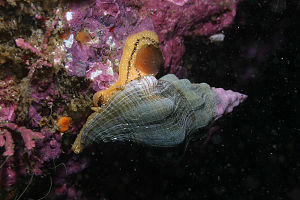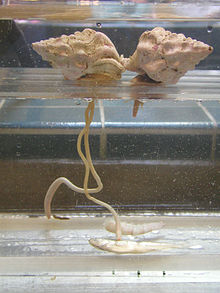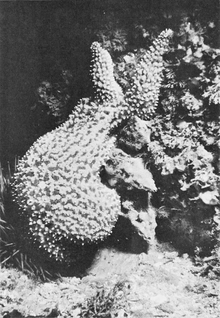Kelletia kelletii
| Kelletia kelletii | ||||||||||||
|---|---|---|---|---|---|---|---|---|---|---|---|---|

Kelletia kelletii |
||||||||||||
| Systematics | ||||||||||||
|
||||||||||||
| Scientific name | ||||||||||||
| Kelletia kelletii | ||||||||||||
| ( Forbes , 1850) |



Kelletia kelletii is a big snail species from the family of horn snails (Buccinidae) attached to the coast of California is located.
features
The right-handed, spindle-shaped, whitish snail shell of Kelletia kelletii has about 6 whorls and reaches a length of about 17.5 cm. It has a curvy seam and ends in a long siphon canal. The surface of the thick-walled housing has distinctive teats. It is often overgrown with bog animals , sponges and algae. The protoconch of Kelletia kelletii has half to one and a half whorls and a rounded tip.
Reproductive cycle
Kelletia kelletii shows sexual dimorphism : When mating, the females are significantly larger than the males. Females become sexually mature with a shell length of 6.5 cm to 7 cm, while males reach sexual maturity between 5 cm and 6 cm.
About 15 to 20, but sometimes also about 200 to 300 females and males come together annually for mating, in which the male mates the female with his penis , in larger groups. The egg capsules are deposited in March, April and May.
The oval egg capsules are placed upright in larger clusters on hard ground - rocks, mollusc shells or shells from other species - where preference is likely to be given to places where egg capsules are already located. Egg-laying can only take one or several days. The egg capsules are 6 mm to 9 mm high, depending on the size of the female, and contain around 400 to 1200 eggs, occasionally up to 2200 eggs.
The embryos first develop in the capsule and leave it around 30 to 34 days after oviposition at 14 to 17 ° C. They then live for several weeks as pelagic , plankton- eating Veliger larvae. The smaller the egg capsule, the larger the hatching Veliger larvae.
In laboratory tests metamorphosed one-third of the larvae aged 5 to 9 weeks to in the presence of rocks with the worm screw Petaloconchus montereyensis , but all the larvae at the age of 8 to 9 weeks at high concentrations of potassium chloride . From this, a pelagic larval period of around five and a half to nine weeks is concluded.
Kelletia kelletii grows slowly with 7 mm to 10 mm per year in the period of sexual maturity and only reaches it late. Sexual maturity is reached with a housing length (from the apex to the tip of the siphon canal) of about 6 cm. After that, the growth slows down further, and a case length of about 9 cm is not reached until around 20 years old.
Distribution and occurrence
Kelletia kelletii lives on the North American Pacific coast between Isla Asunción ( Baja California ) and Monterey ( California ) in kelp forests , rocky reefs and transitions to gravel and sand below the intertidal zone at depths of 2 to 70 m. It is very common on sub-intertidal reefs on the southern California coast. Younger individuals live more hidden than sexually mature ones and bury themselves in the substrate.
nutrition
Kelletia kelletii is both a predator and a scavenger . For this purpose, it can extend its muscular proboscis to about twice the length of the casing and thus reach food in crevices or in the substrate. The food is rasped off with the help of the radula and pumped into the intestines by the muscles in the proboscis. Many individuals are often attracted by a piece of carrion. In one case, Rosenthal (1971) found 85 Kelletia kelletii snails off Point Loma , eating on a dead fish of the genus Paralabrax .
According to research by Rosenthal captured kelletia kelletii as predators among other polychaete ( Diopatra ornata , Phyllochaetopterus prolifica ), mussels ( Adula falcata , Lithophaga plumula , Pododesmus cepio ), snails ( Petaloconchus montereyensis , the turban snails Tegula brunnea and - significantly less - Tegula eiseni that be actively pursued, and the cone snail Conus californicus ), barnacles (the barnacle Megabalanus tintinnabulum ) and sea squirts ( Styela montereyensis ). As a scavenger, it is apparently attracted by all kinds of dead or injured, dying animals and eats the meat of dead mussels ( Chama pellucida , Hinnites multirugosus , Parapholas californica , Platyodon cancellatus , Ventricolaria fordii ), snails ( Astraea undosa , Bursa californica , Jaton festivus ) Cephalopods ( Loligo opalescens ), crabs ( Panulirus interruptus , Taliepus nuttallii ), starfish ( Pisaster giganteus ), sea urchins ( Strongylocentrotus franciscanus , Strongylocentrotus purpuratus ) and fish ( Paralabrax nebulifer , Sphyraena argentea ).
Kelletia kelletii was often observed by Rosenthal near the "giant starfish" Pisaster giganteus while it was eating a prey. Although Pisaster giganteus also eats Kelletia kelletii , it shows no escape reaction . If the starfish is consuming other prey, the advantage for the snail to get hold of its meat obviously outweighs it. As a rule, there are 2 or 3 snails that use their long proboscides to grate away part of the prey from the eating starfish. Other starfish that Kelletia kelletii eats as commensals are Dermasterias imbricata and Pisaster brevispinus .
Predators
Starfish are the main enemies of Kelletia kelletii , including species in which it occurs as a commensal - Pisaster giganteus and Pisaster brevispinus - as well as Astrometis sertulifera . Other predators are octopuses ( Octopus bimaculatus ), moon snails ( Lunatia lewisii ), fish ( Rhacochilus vacca and the horned shark Heterodontus francisci ) and sea otters .
Surname
Kelletia kelletii was first described in 1850 under the name Fusus kelletii by the naturalist Edward Forbes from the Isle of Man . The captain Henry Kellett , who led the expedition from which the type specimen was collected, is honored with the specific epithet and the generic name assigned later .
literature
- Donald Putnam Abbott, Eugene Clinton Haderlie: Prosobranchia , in: Robert Hugh Morris, Donald Putnam Abbott, Eugene Clinton Haderlie: Intertidal Invertebrates of California . Pp. 230-307, here pp. 286, 13.87: Kelletia kelletii (Forbes, 1852) . Stanford University Press, 1st ed., Stanford (CA, USA) 1980.
- MR Romero, KM Walker, CJ Cortez, Y. Sanchez, KJ Nelson, DC Ortega, SL Smick, WJ Hoese, DC Zacherl (2012): Larval Diel Vertical Migration of the Marine Gastropod Kelletia kelletii (Forbes, 1850) . Journal of Marine Biology, Article ID 386575. doi : 10.1155 / 2012/386575 .
- RJ Rosenthal (1971): Trophic interaction between the sea star Pisaster giganteus and the gastropod Kelletia kelletii . Fishery Bulletin 69 (3), pp 669 -679. US Department of Commerce.
- RJ Rosenthal (1970): Observations on the reproductive biology of the Kellet's whelk, Kelletia kelletii (Gastropoda: Neptuneidae) . The Veliger 12 (3), pp. 319-324.
- RJ Rosenthal, WD Clarke, PK Dayton (1974). Ecology and natural history of a stand of giant kelp, Macrocystis pyrifera , off Del Mar California . Fishery Bulletin 72 (3), pp 670 -684. US Department of Commerce.
- K. Hubbard (2008): 2 Kellet's Whelk, Kelletia kelletii . Status of the Fisheries Report 2008, Section 2, pp. 1-6. ( PDF )
- Edward Forbes (1850): On the species of Mollusca collected during the Surveying Voyages of the Herald and Pandora, by Capt. Kellett , RN, CB and Lieut. Wood, RN Proceedings of the Zoological Society of London 18, pp 270- 274 . Pl. IX , Fig. 10.
- HL Cumberland (1995): "A life history analysis of the Kellet's whelk, Kelletia kelletii ". Msc. Thesis, San Diego State University, San Diego (CA). 93 pages.
- HM Feder, R. Lasker (1968): A radula mauscle preparation from the gastropod, Kelletia kelletii , for biochemical essays . The Veliger 10, pp. 283-285.
- Ulysses S. Grant IV , Hoyt Rodney Gale (1931): Catalog of the marine Pliocene and Pleistocene mollusca of California . Memoirs of the San Diego Society of Natural History 1, 1036 pp. 642-543 , Pl. 28 , Fig. 7.
- TJ Herrlinger (1981): Range extension of Kelletia kelletii . The Veliger 24 (1), p. 78.
- SE Koch (2008). Exploring the use of statoliths of Kelletia kelletii as natural tags to estimate population connectivity across a species' range . Thesis, California State University, Fullerton, 53 pages.
- SI Lonhart (2001): An Invasive Whelk as Predator and Prey: the Ecology of Kelletia kelletii in Monterey Bay, California . DPhil. Thesis, University of California, Santa Cruz (CA), 114 pages.
- PN Reilly (1987): Population studies of rock crab, Cancer antennarius , yellow crab, C. anthonyi , and Kellet's whelk, Kelletia kelletii , in the vicinity of Little Cojo Bay, Santa Barbara County, California . California fish and game 73 (2), pp 88 -98.
- D. Zacher, SD Gaines, SI Lonhart (2003): The limits to biogeographical distributions: insights from the northward range extension of the marine snail, Kelletia kelletii (Forbes, 1852) . Journal of Biogeography 30, pp. 913-924. doi : 10.1046 / j.1365-2699.2003.00899.x .


